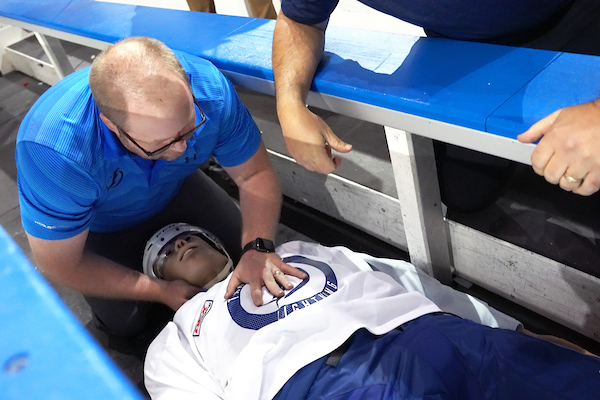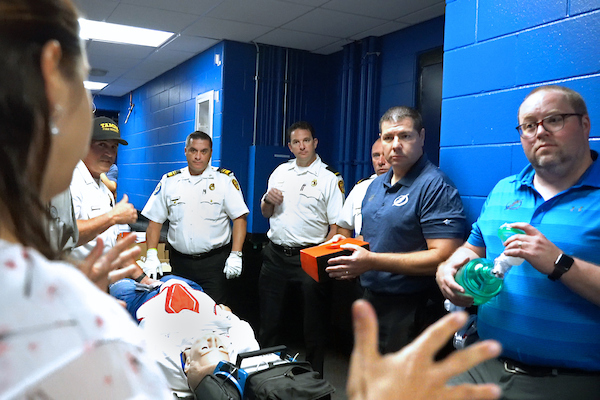When the hockey player is a high-tech manikin, medical professionals take emergency training to a whole new level
The USF Health Center for Advanced Medical Learning and Simulation brought an advanced patient simulator to Amalie Arena Sept. 10 so that Tampa Bay Lightning team physicians and athletic trainers, Tampa Fire Rescue paramedics, and a few USF Health emergency medicine trainees at Tampa General Hospital could more realistically practice life-saving stabilization procedures on the ice.

At the beginning of a simulation scenario, Tom Mulligan, head athletic trainer for the Tampa Bay Lightning, rushes over to an injured “player” down on the ice.
The simulation scenarios were performed on a life-like manikin, fully outfitted in Lightning gear, with laptop-controlled breathing, heart rates and pulses, eyes that could blink and dilate, and an artificial tongue that mimicked a real one. The training exercises included simulations of heart rhythm disturbances and cardiac arrest, as well as airway trauma from a neck injury. An ambulance was standing by just like during actual Lightning games.
“This was a first for us,” said Tom Mulligan, head athletic trainer for the Tampa Bay Lightning. “I’m only aware of one other team that uses a simulator for these rehearsals that we all do.”

From the players’ bench area, the emergency response team prepares to lift the patient simulator strapped to a long board to immobilize the cervical spine.
The annual training helps prepare participants how to respond more effectively as a team in the rare event that an actual hockey player needs emergency care during a game.
For the last few years, the Lightning’s medical staff, paramedics who cover the games and TGH/TEAM Health emergency physicians would talk through scenarios and someone dressed up as a player for the practice. However, team members could not intubate, do cardiopulmonary resuscitation, or perform other emergency procedures on a human being.
“One common theme I kept hearing tonight was practicing with the simulator was a great experience. It really took our training to the next level – a whole new learning curve,” Mulligan said. “We’re extremely fortunate to have USF and CAMLS nearby, literally in our backyard, as a resource.”

Andre Nelson, simulation operations specialist at USF Health CAMLS, looks over the manikin’s computer-programmed medical emergency with CAMLS Executive Director Haru Okuda, MD
Ryan McKenna, DO, simulation director for USF Health’s emergency medicine residency program, helped lead the training on the ice, players’ bench and arena tunnel with CAMLS providing simulation equipment and technical support.
“With this in situ simulation training, we were trying to integrate people from multiple domains and specialties into a unique environment that not everyone practices in on a day-to-day basis,” Dr. McKenna said. “The coolest thing for me was seeing a whole bunch of medical professionals come together to improve process and response times.”
Haru Okuda, MD, the new executive director of USF Health CAMLS, said the center was excited to partner with the Lightning for this first training and looks forward to more opportunities to engage with the Tampa Bay community.
Every team member participating in the training at Amalie Arena is an expert in their discipline and in a familiar setting like the emergency room the simulation scenarios would have likely unfolded with ease, Dr. Okuda said. “But, because here they are in such a foreign environment, with helmet and pads and skates to deal with, you can see what a challenge it can be. Even the experts initially struggled with how to manage the ‘patient.’”
Fortunately, the team is working on a manikin, not an actual player. And they can practice more than once.
“Once they run through a scenario and realize that some of the ways they would normally approach a problem aren’t working, then they are able to restart and try a different way to produce a better patient outcome,” Dr. Okuda said. “So, when the player has a real-life emergency, they can assess it and respond the best possible way.”

Ryan McKenna, DO (center), director of simulation training for the USF Health emergency medicine residency, speaks to the team at a debrief following one of the simulation scenarios.

Jason Wilson, MD, (right) associate medical director of the Emergency Department at Tampa General Hospital, listens to Dr. McKenna lead the debrief.

Rachel Semmons, MD, an emergency physician at TGH/TEAM Health and assistant program director of USF Health’s emergency medicine residency, contributes to the debrief. Dr. Semmons is also co-medical director of Tampa Fire Rescue and USF’s EMS fellowship director.

Diego Riveros, MD, (left) a second-year emergency medicine resident at USF Health, and Anish Zachariah, MD, of TGH/TEAM Health, who directs the third-year emergency medicine clerkship for USF Health medical students.
-Video and photos by Torie M. Doll, USF Health Communications and Marketing





